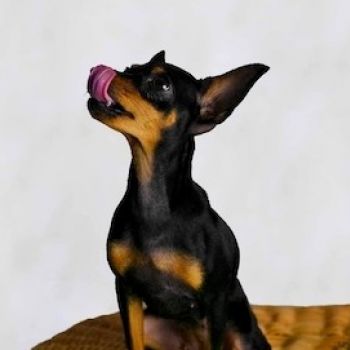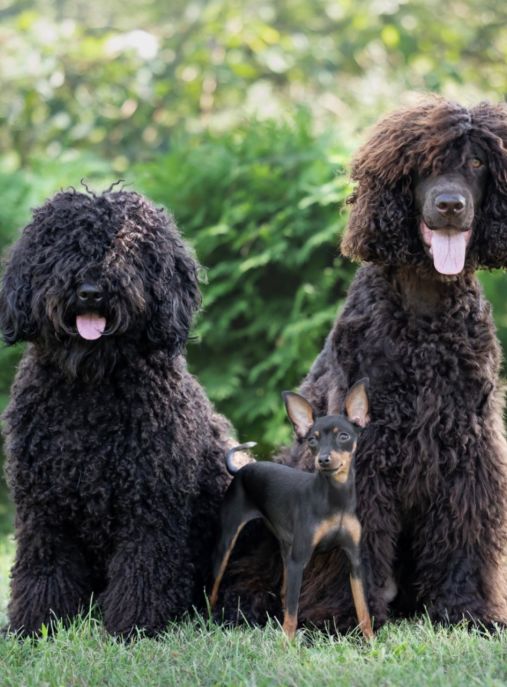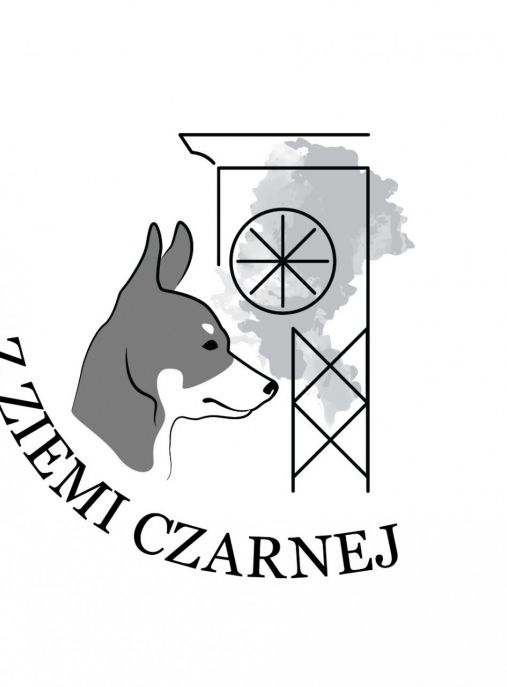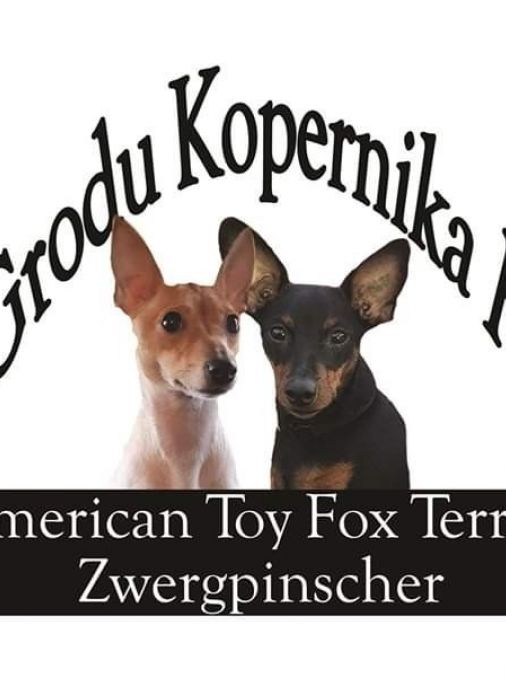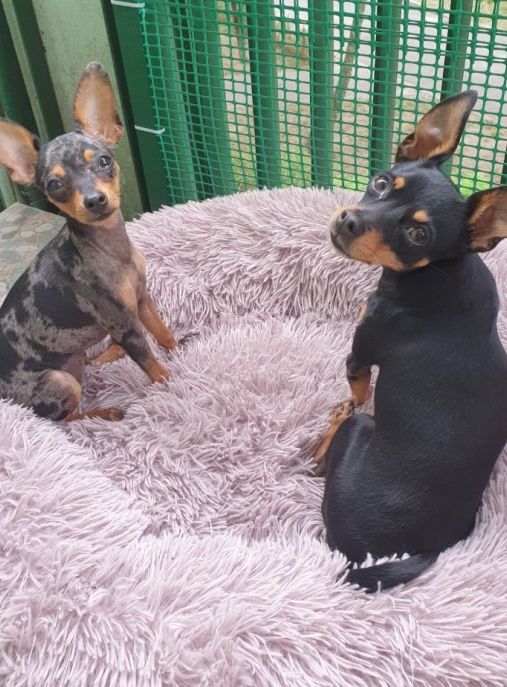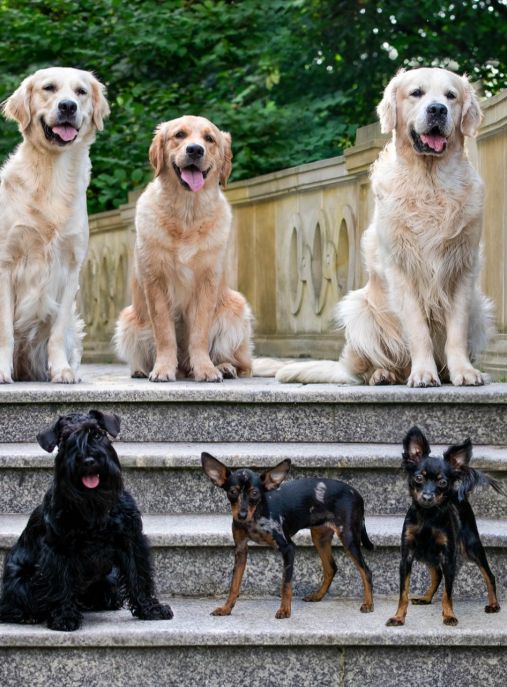The Prague Ratter, also known as the Pražský Krysařík, is a small toy breed that originated in the Czech Republic. This breed is highly regarded for its charming appearance, lively personality, and loyal nature. Despite its small size, the Prague Ratter is a robust and agile dog that is well-suited for various lifestyles.
The history of the Prague Ratter dates back several centuries, with its origins believed to trace back to ancient Asian toy breeds. These small dogs were brought to Europe by traders and eventually found their way to Prague, where they were selectively bred to create the modern-day Prague Ratter. This breed gained popularity among the European aristocracy, particularly in the 16th century, and was often seen accompanying noble ladies in their palaces and gardens.
According to the FCI (Fédération Cynologique Internationale) typology, the Prague Ratter belongs to Group 9 - Companion and Toy Dogs. This group includes small-sized dogs that are primarily bred for companionship and have a friendly and affectionate temperament. The Prague Ratter is a member of Section 9 - Continental Toy Spaniels and Russian Toy, which comprises similar toy breeds with shared characteristics.
The Prague Ratter is an ideal companion for individuals or families looking for a small, affectionate, and adaptable dog. They thrive in a loving and attentive environment and are known to form strong bonds with their owners. Due to their small size, they are well-suited for apartment living and can adapt to various living conditions. However, they do require regular exercise and mental stimulation to prevent boredom and ensure their overall well-being.
In terms of physical characteristics, the Prague Ratter is a tiny dog with a well-proportioned body. The average weight of a Prague Ratter ranges from 1.5 to 3.5 kilograms (3.3 to 7.7 pounds), with males typically being slightly larger than females. Their height at the withers is around 20 to 23 centimeters (8 to 9 inches). Despite their small size, they possess a sturdy and muscular build, allowing them to be agile and active.
The Prague Ratter has a short, smooth coat that comes in a variety of colors, including black, brown, blue, and tan. Their coat is low-maintenance and requires minimal grooming. Regular brushing and occasional bathing are sufficient to keep their coat clean and healthy.
With proper care and nutrition, the Prague Ratter has an average life expectancy of 12 to 14 years. However, it is important to note that individual dogs may vary, and factors such as genetics, diet, exercise, and overall health can influence their lifespan.
One interesting fact about the Prague Ratter is its exceptional intelligence. This breed is highly trainable and eager to please its owner. They excel in various dog sports and activities, including obedience, agility, and even tricks. Their small size and intelligence make them excellent candidates for canine sports that require precision and quick thinking.
Despite their intelligence, the Prague Ratter can be prone to stubbornness and may exhibit a strong-willed nature at times. Consistent and positive reinforcement training methods are essential to ensure their obedience and prevent any behavioral issues.
In conclusion, the Prague Ratter is a delightful toy breed that offers companionship, loyalty, and a charming presence. With their small size, adaptability, and intelligence, they make excellent pets for individuals or families seeking a loving and lively companion. Whether in a bustling city or a quiet countryside, the Prague Ratter is sure to bring joy and endless entertainment to its owners.
The Prague Ratter, also known as the Pražský Krysařík, is a small and lively breed that originated in the Czech Republic. Despite their tiny size, these dogs possess a unique and charming character that sets them apart from other breeds. With their playful nature and affectionate demeanor, Prague Ratters make excellent companions for individuals and families alike.
One of the most notable traits of the Prague Ratter is their intelligence. These dogs are highly intelligent and quick learners, which makes them relatively easy to train. They thrive on mental stimulation and enjoy engaging in various activities that challenge their minds. This breed is known for its ability to quickly pick up commands and tricks, making them a joy to train.
In terms of behavior, Prague Ratters are generally friendly and sociable. They are known to be loyal and devoted to their owners, often forming strong bonds with them. While they may be reserved with strangers initially, they tend to warm up quickly and become affectionate towards new people. This breed is not typically aggressive or territorial, making them a good choice for households with other pets or children.
Despite their small size, Prague Ratters are energetic and lively dogs. They have a playful nature and enjoy interactive games and toys. Regular exercise is essential to keep them physically and mentally stimulated. Daily walks, playtime, and interactive toys can help fulfill their exercise needs. However, it is important to note that due to their small size, they do not require extensive exercise and can adapt well to apartment living.
When it comes to raising and training a Prague Ratter, consistency and positive reinforcement are key. These dogs respond best to reward-based training methods, such as treats and praise. Harsh training techniques or punishment can be counterproductive and may lead to fear or anxiety in these sensitive dogs. Early socialization is also crucial to ensure they grow up to be well-rounded and confident dogs.
Prague Ratters are known for their alertness and tendency to bark. While this can make them excellent watchdogs, it is important to train them to control excessive barking. Teaching them the "quiet" command from an early age can help manage their vocal tendencies.
Due to their small size, Prague Ratters require special care. They are prone to dental issues, so regular teeth brushing and dental check-ups are essential. Additionally, they may be more susceptible to cold weather, so providing them with appropriate clothing during colder months is recommended.
In conclusion, Prague Ratters are intelligent, affectionate, and playful dogs that make wonderful companions. With proper training, socialization, and care, they can thrive in various living situations. Whether you are looking for a loyal lap dog or an active playmate, the Prague Ratter is a breed worth considering.
The Prague Ratter, also known as the Pražský Krysařík, is a small and lively toy breed that originated in the Czech Republic. Despite their tiny size, these dogs are full of energy and require proper care to ensure their well-being. Here is an extensive description of the recommended care for Prague Ratter dogs, along with tips on what to do and what not to do when caring for this breed.
1. Exercise: Prague Ratters may be small, but they have a high energy level. Regular exercise is crucial to keep them happy and healthy. Aim for at least 30 minutes of exercise daily, which can include walks, playtime, and mental stimulation activities. However, be cautious not to overexert them due to their small size and delicate bone structure.
2. Socialization: Prague Ratters are social dogs and enjoy the company of their human family. They can be prone to separation anxiety if left alone for long periods. Ensure they have plenty of social interaction, both with you and other dogs. Early socialization is essential to prevent them from becoming overly timid or aggressive.
3. Grooming: The Prague Ratter has a short, smooth coat that requires minimal grooming. Regular brushing with a soft bristle brush will help keep their coat clean and shiny. Pay attention to their teeth, as small dog breeds are prone to dental issues. Regular tooth brushing and dental check-ups are necessary to maintain their oral health.
4. Feeding: Provide a well-balanced diet that meets the nutritional needs of your Prague Ratter. Consult with your veterinarian to determine the appropriate portion sizes and feeding schedule based on their age, weight, and activity level. Avoid overfeeding, as this breed is prone to obesity, which can lead to various health problems.
5. Training: Prague Ratters are intelligent and eager to please, making them relatively easy to train. Use positive reinforcement techniques such as treats, praise, and rewards to motivate them. Consistency, patience, and early training will help prevent any behavioral issues from developing.
6. Health care: Regular veterinary check-ups are crucial to monitor your Prague Ratter's overall health. Vaccinations, parasite prevention, and routine examinations are essential. Due to their small size, they may be more susceptible to certain health conditions such as patellar luxation, dental problems, and allergies. Be vigilant and seek prompt veterinary care if you notice any signs of illness or discomfort.
7. Safety precautions: Prague Ratters are curious and agile, so it's important to create a safe environment for them. Secure your home and yard to prevent any potential hazards or escapes. Be cautious with open doors and windows, as they can easily slip through small spaces. Avoid leaving them unattended near larger dogs or children who may accidentally harm them due to their delicate size.
What to do:
- Provide regular exercise and mental stimulation.
- Socialize them from an early age.
- Maintain a consistent grooming routine.
- Feed a balanced diet and monitor portion sizes.
- Use positive reinforcement training techniques.
- Schedule regular veterinary check-ups.
- Create a safe environment for your Prague Ratter.
What not to do:
- Overexert them during exercise.
- Leave them alone for extended periods without social interaction.
- Neglect their dental care.
- Overfeed or provide an unbalanced diet.
- Use harsh training methods or punishment.
- Ignore signs of illness or discomfort.
- Expose them to potential dangers or unsafe situations.
By following these tips and providing the recommended care, you can ensure that your Prague Ratter remains a happy, healthy, and well-adjusted companion for years to come.
The Prague Ratter, also known as the Pražský Krysařík, is a small and elegant breed of dog that originated in the Czech Republic. These dogs are known for their lively and alert nature, as well as their distinctive appearance. When it comes to their color, Prague Ratters can display a variety of shades, but there is one common color that is often associated with this breed.
The most common color of Prague Ratter dogs is a rich and glossy black. This deep black hue covers their entire body, from the tip of their nose to the end of their tail. The coat of a Prague Ratter is short and smooth, which enhances the intensity of the black color and gives it a sleek and polished appearance.
One of the striking features of the black Prague Ratter is the way their coat reflects light. When the sun hits their fur, it creates a beautiful sheen that adds to their overall allure. This reflective quality gives the black Prague Ratter a regal and sophisticated look, making them stand out in a crowd.
In addition to their black coat, Prague Ratters may also have small patches of white on their chest or toes. These white markings provide a delightful contrast to the deep black color, adding a touch of elegance and uniqueness to their appearance. The white patches can vary in size and shape, making each Prague Ratter truly one-of-a-kind.
Another interesting aspect of the black Prague Ratter's color is the way it can change with age. As these dogs mature, their black coat may develop a slight graying or silvering effect. This natural aging process gives them a distinguished and wise appearance, reminiscent of a seasoned companion.
While black is the most common color, it's important to note that Prague Ratters can also come in other colors. Some individuals may have a chocolate brown coat, which is equally stunning and eye-catching. Others may have a combination of black and tan, with the black forming the majority of their coat and the tan appearing on their face, chest, and legs.
In conclusion, the common color of Prague Ratter dogs is a deep and lustrous black. This color, combined with their sleek and shiny coat, gives them an air of elegance and sophistication. Whether they have small white markings or age gracefully with a touch of silver, the black Prague Ratter is a truly captivating breed that is sure to turn heads wherever they go.
The Prague Ratter, also known as the Pražský Krysařík, is a small and lively toy breed originating from the Czech Republic. Despite their small size, these dogs have a big personality and require proper nutrition to support their overall health and well-being. In this text, we will provide an extensive description of the nutrition requirements for Prague Ratter dogs, including advice on what and how to feed them, as well as things to avoid.
Prague Ratters are energetic and agile dogs, so it is crucial to provide them with a well-balanced diet that meets their nutritional needs. The primary components of their diet should include high-quality proteins, healthy fats, complex carbohydrates, vitamins, and minerals. Here are some key points to consider when feeding a Prague Ratter:
1. High-quality proteins: Proteins are essential for muscle development and repair. Choose lean sources of protein such as chicken, turkey, fish, or lamb. Avoid processed meats or those with excessive fat content.
2. Healthy fats: Fats provide energy and support the absorption of fat-soluble vitamins. Include sources of healthy fats like fish oil, flaxseed oil, or coconut oil in their diet. Avoid excessive amounts of saturated fats or trans fats.
3. Complex carbohydrates: Carbohydrates are a vital energy source for active dogs. Opt for complex carbohydrates like whole grains (brown rice, quinoa) and vegetables (sweet potatoes, peas). Avoid simple carbohydrates found in processed foods or sugary treats.
4. Fresh fruits and vegetables: These provide essential vitamins, minerals, and antioxidants. Incorporate a variety of fruits and vegetables into their diet, such as carrots, apples, blueberries, and spinach. Avoid toxic foods like grapes, raisins, onions, and garlic.
5. Portion control: Prague Ratters are prone to obesity, so it is crucial to monitor their food intake. Follow the feeding guidelines provided by your veterinarian or dog food manufacturer and adjust portions based on your dog's age, weight, and activity level.
6. Hydration: Always provide fresh and clean water for your Prague Ratter. Ensure they have access to water throughout the day, especially during hot weather or after physical activity.
7. Avoid overfeeding and table scraps: Prague Ratters have small stomachs, so it's important not to overfeed them. Avoid giving them table scraps, as some human foods can be toxic or cause digestive issues.
8. Regular feeding schedule: Establish a consistent feeding schedule to help regulate their digestion and prevent overeating. Divide their daily food portion into two or three meals, depending on their age and activity level.
9. Regular veterinary check-ups: Regular visits to the veterinarian are essential to monitor your Prague Ratter's overall health and ensure they are receiving proper nutrition. Your vet can provide specific dietary recommendations based on your dog's individual needs.
10. Treats and rewards: Use healthy treats specifically designed for dogs as rewards during training or for occasional indulgence. Avoid giving them excessive treats, as it can contribute to weight gain.
Remember, every dog is unique, and individual dietary needs may vary. It is always recommended to consult with your veterinarian for personalized advice on feeding your Prague Ratter based on their specific requirements and any underlying health conditions they may have. By providing a balanced and nutritious diet, you can help your Prague Ratter live a long, healthy, and happy life.

